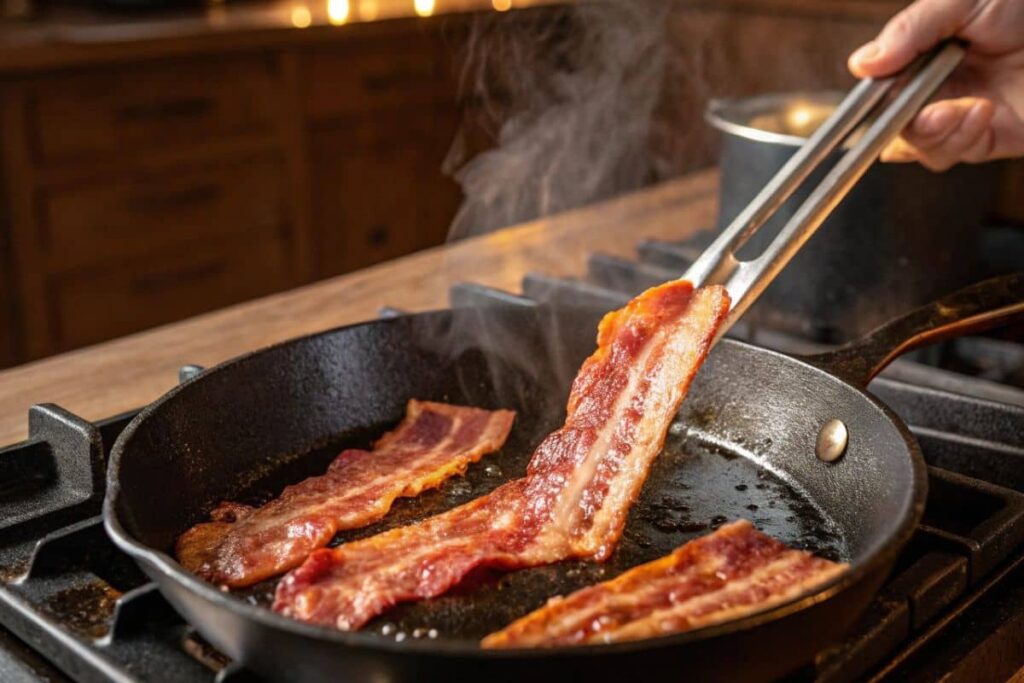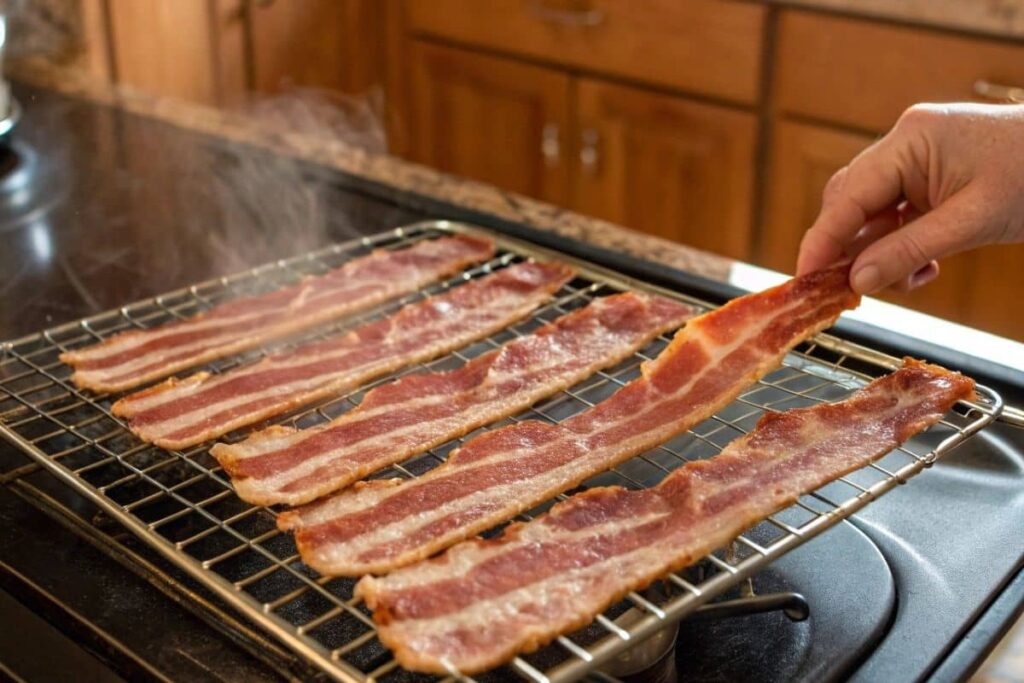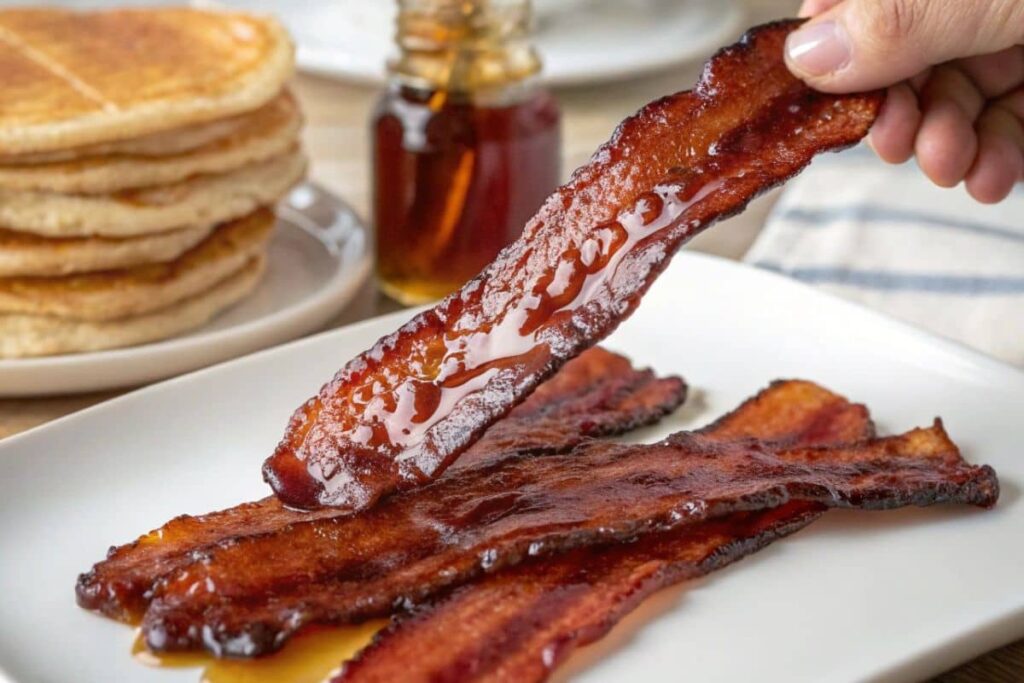How to Cook Beef Bacon perfectly every time? You’re in the right place! Beef bacon is a delicious, smoky alternative to pork bacon, and with the right techniques, you can achieve crispy, flavorful results that’ll make any meal unforgettable.
Whether you’re frying it on the stovetop, baking it in the oven, or even grilling it, this guide will show you step-by-step how to master beef bacon like a pro.
Ready to transform your breakfast (or any dish) with perfectly cooked beef bacon? Let’s dive in!
Table of Contents

Why Beef Bacon Deserves a Place in Your Kitchen
Beef bacon is the underdog of the bacon world. It’s less greasy, often thicker, and packs a punch with its meaty flavor. Plus, it’s a fantastic option if you’re looking for something halal, kosher, or just want to switch things up. Think of it as the cool cousin of pork bacon—it’s familiar yet unique, and totally worth a try!
“Beef bacon is like the jazz of breakfast meats—smooth, bold, and full of personality!”
What Makes Beef Bacon Unique?
Beef bacon comes from the belly or brisket of the cow, offering a richer flavor and a firmer texture compared to pork bacon. It’s typically cured and smoked, which gives it that classic bacon taste we all love. But unlike its pork counterpart, beef bacon has a slightly beefier edge that makes it stand out.
Choosing the Best Cut for Perfect Results
If you want amazing results, it all starts with choosing the right cut. Not all options are created equal, so here are some things to look out for:
Fresh vs. Frozen: What to Look For
Fresh is usually your best bet for flavor and texture. Look for pieces with a good balance of meat and fat—they should be marbled, not too lean. If you’re buying frozen, make sure it’s vacuum-sealed and free from frost or ice crystals, which can affect taste and texture.
How to Identify High-Quality Options
Premium cuts will have a deep, reddish color and a slight sheen from the fat. Avoid pieces that look overly processed or have a grayish hue. And don’t forget to check the label! Look for minimal additives—just beef, salt, spices, and maybe a touch of sugar for curing.
Tools and Equipment for Cooking
Before diving into the process, let’s talk tools. You don’t need a fancy kitchen setup, but having the right gear makes a huge difference.
The Ideal Pan for Crispy Perfection
A cast-iron skillet is the ultimate choice. Why? It distributes heat evenly, giving you that golden-brown crisp everyone loves. If you don’t have one, a stainless-steel pan works just fine—just avoid non-stick surfaces, as they don’t sear as well.
Other Useful Tools for Perfect Results
- Spatula: A sturdy one to flip those strips without breaking them.
- Paper towels: For draining excess grease.
- Oven rack: Perfect for baking beef bacon to crisp perfection.

Preparing for the Best Cooking Results
Preparation is key to making your bacon crispy on the outside and tender on the inside. Here’s how to set yourself up for success:
Should You Marinate? Pros and Cons
Marinating can enhance flavor, but it’s not always necessary. If you’re feeling adventurous, try a quick mix of soy sauce, garlic, and honey for a sweet-savory kick. Prefer the classic taste? Skip the marinade and stick to the basics.
The Right Way to Defrost
Never defrost in the microwave—it’ll cook unevenly and lose texture. Instead, let it thaw overnight in the fridge or use the cold-water method if you’re short on time. Trust me, patience pays off here!
Step-by-Step Methods to Cook Beef Bacon
Now, the moment you’ve been waiting for: how to actually cook beef bacon! Here are the best methods to achieve perfection:
Cooking Beef Bacon on the Stovetop
- Preheat your skillet over medium heat.
- Lay the beef bacon strips flat in the pan—don’t overcrowd!
- Cook for 3-4 minutes on each side, or until crispy.
- Transfer to a plate lined with paper towels to absorb excess grease.
Pro tip: Use tongs to flip the bacon gently. And don’t crank up the heat too high—slow and steady wins the race!
Baking Beef Bacon in the Oven
- Preheat your oven to 400°F (200°C).
- Place a wire rack on a baking sheet and lay the bacon strips on top.
- Bake for 15-20 minutes, flipping halfway through for even crispness.
- Let it cool slightly before serving—oven-baked bacon stays crispy longer!
This method is perfect if you’re cooking for a crowd or don’t want to babysit the skillet. Less mess, more bacon—what’s not to love?
Air Fryer Method for Crispy Beef Bacon
If you’re lucky enough to own an air fryer, use it! Preheat your air fryer to 375°F (190°C), lay the bacon strips in a single layer, and cook for 8-10 minutes. Flip them halfway through, and you’ll have crispy bacon with minimal grease—talk about a win-win!
Grilling Beef Bacon for a Smoky Flavor
Want to add a little smoky charm to your beef bacon? Grilling is the way to go. Imagine the sizzling sound of bacon over the flame—mouthwatering, right? Here’s how to do it:
- Preheat your grill to medium heat.
- Brush the grates with a little oil to prevent sticking.
- Lay the beef bacon strips across the grill, perpendicular to the grates.
- Cook for about 2-3 minutes per side, keeping an eye on them to prevent burning.
- Remove and let them cool for a minute before serving.
Grilled beef bacon has a slightly charred edge that’s irresistible. Just make sure to keep a close watch—grills can be unpredictable, and nobody likes burnt bacon!
Can You Microwave Beef Bacon? Tips and Tricks
Short on time? The microwave can be a lifesaver. While it might not give you that perfect crisp, it’s a quick and easy method:
- Line a microwave-safe plate with paper towels.
- Place the beef bacon strips in a single layer, then cover with another paper towel.
- Microwave on high for 3-4 minutes, checking after every minute.
- Let it cool slightly before serving—it’ll crisp up as it cools!
Microwaving is perfect for those busy mornings when you need bacon in a flash. Just don’t forget the paper towels—they absorb the grease and keep things clean!
Troubleshooting Common Problems in Cooking
Let’s be real, cooking this type of bacon isn’t always smooth sailing. But don’t worry—I’ve got solutions to the most common issues:
Why Does It Turn Out Too Chewy?
If your strips feel more like jerky, they’re probably overcooked. Since this variety is naturally thicker than pork, it requires a bit of finesse. Keep the heat moderate, and flip frequently for even cooking.
Preventing It from Burning
Burnt bacon? No, thank you! The trick is to cook it low and slow. High heat might be tempting, but it’ll scorch the outside before the inside is done. And always keep an eye on it—it goes from perfect to burnt faster than you think!
Solving the Problem of Excess Grease
This cut tends to release a lot of grease, which can make it soggy if you’re not careful. Use a wire rack when baking or pat it dry with paper towels after cooking to get that crispy finish.
Flavor Enhancements: Take It to the Next Level
Want to level up your bacon game? Here are some ideas to jazz up your strips:
Adding Spices and Rubs for Extra Taste
Season with a dash of black pepper, garlic powder, or smoked paprika before cooking. As it sizzles, the spices will infuse it with a rich, caramelized flavor that’s absolutely irresistible!
How to Make Maple-Glazed Beef Bacon
- Whisk together 2 tablespoons of maple syrup and 1 teaspoon of Dijon mustard.
- Brush the glaze onto your bacon strips during the last few minutes of cooking.
- Let it caramelize, then remove from heat and enjoy!
The sweet-savory combo is absolutely divine and pairs perfectly with pancakes or waffles. Trust me, this is a game-changer! 🍁
Storing and Reheating Cooked Beef Bacon
The Best Ways to Store Leftover Beef Bacon
- In the Fridge: Store cooked beef bacon in an airtight container for up to 5 days.
- In the Freezer: Wrap individual strips in parchment paper, then seal in a freezer bag. They’ll keep for up to 3 months.
Pro tip: Freeze beef bacon in small, portioned batches to make meal prep easier. This way, you can defrost just the amount you need, reducing waste and keeping the rest fresh for longer! 🥓❄️
How to Reheat Beef Bacon Without Losing Its Crispness
Reheating bacon can be tricky—nobody wants rubbery strips. The best way is to use an oven:
- Preheat your oven to 350°F (175°C).
- Place the bacon on a baking sheet lined with foil.
- Heat for 5-7 minutes, or until warmed through.
You can also use a skillet or air fryer for smaller portions. Just avoid the microwave—it tends to make bacon soggy.

Creative Ways to Use This Flavorful Bacon
This smoky, crispy ingredient isn’t just for breakfast! Here are some delicious ways to incorporate it into your meals:
Breakfast Ideas: A Flavorful Start to Your Day
Think beyond the classic eggs and bacon. Try it in a breakfast burrito, sprinkled on avocado toast, or layered in a hearty sandwich. It’s the ultimate way to kickstart your morning with a burst of savory goodness!
Adding It to Salads and Wraps
Crumble crispy strips over a fresh Caesar salad for a smoky crunch, or wrap them around grilled veggies for a delicious appetizer. This ingredient is versatile and adds depth to any dish.
Elevating Your Dinner Game
Why not take dinner up a notch? Add it to pasta carbonara, layer it on gourmet burgers, or use it as a crispy topping for baked potatoes. The possibilities are endless!
The Nutritional Profile of Beef Bacon
Curious about the health side of things? Here’s a quick breakdown:
| Nutrient | Per 2 Strips (Average) |
|---|---|
| Calories | 90 |
| Protein | 7g |
| Fat | 7g |
| Sodium | 300mg |
Beef bacon is slightly leaner than pork bacon, making it a great choice if you’re watching your fat intake. Just enjoy it in moderation—it’s still a treat!
Conclusion: Perfecting the Art of Cooking Beef Bacon
Cooking beef bacon perfectly every time doesn’t have to be complicated. With the right techniques and a little practice, you’ll be dishing out crispy, flavorful strips that rival even the best pork bacon. So, what are you waiting for? Fire up your skillet, oven, or grill and get cooking!
“Bacon is proof that happiness can be fried.”
Frequently Asked Questions About Cooking Beef Bacon
Is Beef Bacon Unhealthy?
Beef bacon can be part of a healthy diet if enjoyed in moderation. It’s slightly leaner than pork bacon but still contains fats and sodium, so overindulging might not be the best idea. Pair it with nutrient-rich foods like fresh veggies or whole grains to balance your meal.
Want to learn more about its health impact? Check out Is Beef Bacon Unhealthy? for detailed insights and tips!
What Makes Beef Bacon Special?
Beef bacon isn’t just a pork alternative—it’s a flavor-packed ingredient with a meaty texture and smoky profile. It’s perfect for those looking to try something new or stick to dietary preferences like halal or kosher.
Discover more about this delicious ingredient on our Beef Bacon page, where we share everything you need to know about its origin, preparation, and versatility!
How Do You Cook Bacon-Wrapped Beef Filet?
Bacon-wrapped beef filet is a showstopper dish that combines juicy steak with the smoky flavor of bacon. Start by seasoning your filet, wrapping it with beef bacon, and searing it on high heat before finishing in the oven for a perfect medium-rare finish.
For a detailed step-by-step guide, visit How to Cook Bacon-Wrapped Beef Filet and impress your guests with this restaurant-quality meal!
